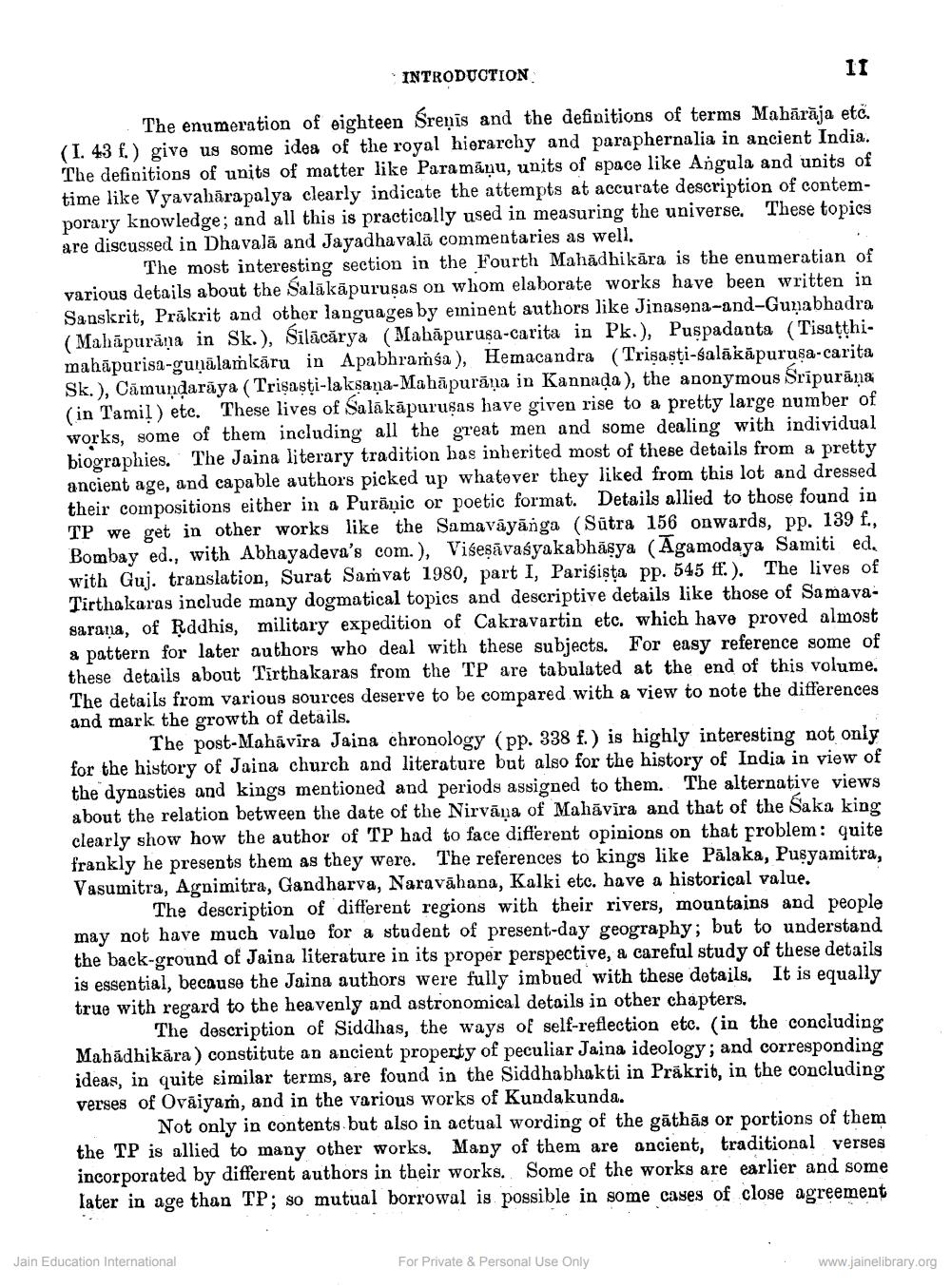________________
INTRODUCTION
11
The enumeration of eighteen Śrenis and the definitions of terms Mahārāja etc. (I. 43 £) give us some ides of the royal hierarchy and paraphernalia in ancient India. The definitions of units of matter like Paramaņu, units of space like Angula and units of time like Vyavaharapalya clearly indicate the attempts at accurate description of contemporary knowledge; and all this is practically used in measuring the universe. These topics. are discussed in Dhavala and Jayadhavala commentaries as well.
The most interesting section in the Fourth Mahadhikara is the enumeratian of various details about the Salakāpurusas on whom elaborate works have been written in Sanskrit, Prakrit and other languages by eminent authors like Jinasena-and-Gunabhadra (Mahapurana in Sk.), Silacarya (Mahapurusa-carita in Pk.), Puspadanta (Tisatthimahāpurisa-gunālaṁkāru in Apabhramsa), Hemacandra (Trisasti-salakāpurusa-carita Sk.), Camundaraya (Trisasti-laksana-Mahapurana in Kannada), the anonymous Sripuran (in Tamil) ete. These lives of Salakāpurugas have given rise to a pretty large number of works, some of them including all the great men and some dealing with individual biographies. The Jaina literary tradition has inherited most of these details from a pretty ancient age, and capable authors picked up whatever they liked from this lot and dressed their compositions either in a Puranic or poetic format. Details allied to those found in TP we get in other works like the Samaväyänga (Sütra 156 onwards, pp. 139 f., Bombay ed., with Abhayadeva's com.), Visesävasyakabhasya (Agamodaya Samiti ed. with Guj. translation, Surat Samvat 1980, part I, Parisista pp. 545 ff). The lives of Tirthakaras include many dogmatical topies and descriptive details like those of Samavasarana, of Rddhis, military expedition of Cakravartin etc. which have proved almost a pattern for later authors who deal with these subjects. For easy reference some of these details about Tirthakaras from the TP are tabulated at the end of this volume, The details from various sources deserve to be compared with a view to note the differences and mark the growth of details.
The post-Mahavira Jaina chronology (pp. 338 f.) is highly interesting not only for the history of Jaina church and literature but also for the history of India in view of the dynasties and kings mentioned and periods assigned to them. The alternative views. about the relation between the date of the Nirvana of Mahavira and that of the Saka king clearly show how the author of TP had to face different opinions on that problem: quite frankly he presents them as they were. The references to kings like Palaka, Pusyamitra, Vasumitra, Agnimitra, Gandharva, Naravahana, Kalki ete. have a historical value.
The description of different regions with their rivers, mountains and people may not have much value for a student of present-day geography; but to understand. the back-ground of Jaina literature in its proper perspective, a careful study of these details is essential, because the Jaina authors were fully imbued with these details. It is equally true with regard to the heavenly and astronomical details in other chapters.
The description of Siddhas, the ways of self-reflection etc. (in the concluding Mahadhikara) constitute an ancient property of peculiar Jaina ideology; and corresponding ideas, in quite similar terms, are found in the Siddhabhakti in Prakrit, in the concluding verses of Ovaiyam, and in the various works of Kundakunda.
Not only in contents but also in actual wording of the gathãs or portions of them the TP is allied to many other works, Many of them are ancient, traditional verses incorporated by different authors in their works. Some of the works are earlier and some later in age than TP; so mutual borrowal is possible in some cases of close agreement
Jain Education International
For Private & Personal Use Only
www.jainelibrary.org




